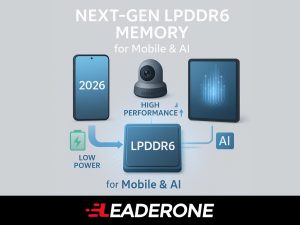
Futuristic concept showing LPDDR6 memory powering mobile and AI devices, emphasizing performance and power efficiency.
The LPDDR6 standard has been officially released by the JEDEC Solid State Technology Association. This critical development marks the next generation of low-power double data rate (LPDDR) memory, designed to bring significant advancements to mobile devices, AI workloads, and other power-sensitive applications. Following years of dedicated effort, the JESD209-6 specification is now public, setting the stage for faster performance and smarter energy use in future electronics.
LPDDR6: Designed for Performance and Efficiency
The LPDDR6 standard builds upon its predecessors (LPDDR5, LPDDR5X, LPDDR5T) with key architectural improvements focused on balancing performance and power efficiency. A notable feature is its dual sub-channel architecture. Each sub-channel uses 12 data lines and four command/address lines. This setup is engineered to handle high-bandwidth tasks. It also remains efficient in compact system designs.
Key benefits of the newly published LPDDR6 standard include:
- Higher Data Rates: LPDDR6 is expected to offer significantly increased data rates, with minimum speeds starting from 10.667 Gbps and potentially reaching up to 14.400 Gbps. This will provide a substantial boost in memory bandwidth.
- Improved Power Efficiency: Despite the higher performance, the standard emphasizes reduced power consumption. This is crucial for extending battery life in mobile devices and improving energy efficiency in AI inference at the edge.
- Enhanced Security Options: The new standard also incorporates robust security features. This addresses the growing need for secure memory in connected devices.
- Small Access Granularity: LPDDR6 maintains a small access granularity of 32 bytes. This allows for flexible operation while handling high-demand tasks.
Impact on Mobile Devices and AI Workloads
The primary beneficiaries of the LPDDR6 standard will be smartphones, tablets, and other portable devices. They demand high bandwidth for complex applications, gaming, and multimedia while requiring minimal power draw. The standard’s focus on power efficiency makes it ideal for extending battery life without sacrificing performance.
Furthermore, LPDDR6 will play a vital role in AI workloads, especially at the edge. Edge AI devices, from smart sensors to autonomous systems, require powerful yet energy-efficient memory to process data locally. LPDDR6’s capabilities will enable more sophisticated AI inference and machine learning tasks directly on devices, reducing reliance on cloud computing.
Market Availability and Outlook
While the LPDDR6 standard is now official (July 2025), industry experts generally anticipate that products featuring LPDDR6 memory will begin appearing around 2026. The transition from standard finalization to mass production and integration into commercial devices typically takes time for chip manufacturers, OEMs, and ecosystem partners to implement the new specifications, conduct testing, and scale production.
Major memory manufacturers like Samsung and SK Hynix, deeply involved in JEDEC’s standardization efforts, will be at the forefront of LPDDR6 production. Their focus will likely shift to this new generation as demand for LPDDR5 and HBM continues to grow for high-end applications. The introduction of LPDDR6 signifies a significant leap forward in memory technology, promising more powerful and energy-efficient computing experiences across a wide range of devices.
